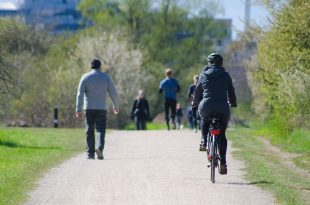Jane Houghton Project Manager, Green Infrastructure Standards Project at Natural England, tells us about our latest review of research into the health benefits presented by green infrastructure.
This week we have published a review of research into the health and wellbeing benefits of ‘green infrastructure’ – that is, the great variety of green and natural spaces such as parks, woodlands, gardens, waterways and street trees.
The review found that people who live in neighbourhoods with greater amounts of green infrastructure tend to be happier, healthier and live longer lives than those who live in less green places. While it is likely that everybody benefits from green infrastructure, it suggested that more disadvantaged communities may benefit the most.
The purpose of the report is to understand more about the types and amounts of green infrastructure that are most beneficial for the health of different communities to help local authorities, landowners and communities enhance the nation’s green infrastructure provision.
The review, in collaboration with Public Health England (PHE) and other partners, is part of our development of a framework for green infrastructure standards which will help to create and support a network of new and existing green spaces throughout urban areas.
PHE’s Director of Health Improvement, Professor John Newton commented:
“This timely report raises awareness of the strength and sizeable body of evidence available showing the health and wellbeing benefits of green infrastructure, and the role it can play in reducing health inequalities.
The report is an important resource that can be used to support delivery of local green infrastructure to sustain and improve communities’ health.
The report found that:
- Having different types of green infrastructure close to people’s homes, places of work or education, or along transportation routes, is likely to maximise the potential ways in which people benefit.
- Both public green infrastructure, such as street trees, parks, and playgrounds and private ones such as gardens are important and support health in different ways.
- Green infrastructure that is well looked after is more likely to be perceived as safe and inviting, and therefore used.
- A good understanding of the needs and desires of local communities will help ensure new or improved provision of green infrastructure is suitable.
- Care must be taken to understand the potential impacts of actions and to ensure that provision of green infrastructure is equitable, fair and does not increase inequalities in health between different social groups.
The development of the National Framework of Green Infrastructure Standards, a commitment in the Government’s 25 Year Environment Plan, aims to green our towns and cities for health and wellbeing, nature, climate resilience and prosperity, in particular for disadvantaged urban populations.
We have taken on board these findings in our work to design a new Framework of Green Infrastructure Standards to advise local authorities and other stakeholders about including green infrastructure in new housing developments, and to green existing public spaces and streets where needed. These can bring benefits not only to access and recreation, but also increase wildlife, improve air quality, provide cooler areas during heatwaves and reduce the likelihood of flooding.
We are also working with the Department for Environment, Food and Rural Affairs, PHE, the Ministry of Housing, Communities and Local Government (MHCLG) and wider governmental and sector stakeholders to deliver the Framework of Green Infrastructure Standards. We are trialling the emerging Framework of Green Infrastructure Standards in 10 areas across England between September 2020 and March 2021, to seek feedback and co-develop the draft framework ready for a soft launch and further trialling in 2021.
The effect of the pandemic this year has underlined the importance of local green space to people. Our People and Nature survey found that the vast majority of adults (89 per cent) agreed or strongly agreed that green and natural spaces should be good places for mental health and wellbeing, with 30 per cent reporting visiting local green and natural spaces more than usual (Natural England, 2020). So, the evidence in this report will be of tremendous value in helping to shape and inform the work Natural England is driving forward on green social prescribing together with the National Academy for Social Prescribing, Defra, NHS, MHCLG, PHE and Sport England.
To encourage the new connection with nature that so many people have developed during this period, and sustain the benefits for their health and wellbeing, we need to create more, bigger, better and joined-up green spaces, especially near to where people live, and to address inequalities. As our Chair Tony Juniper has said: “Nature needs to move to front and centre in how we plan for the future of our country at this pivotal moment.”

1 comment
Comment by Simon Odell posted on
Could you add a link to the research report referred to please?